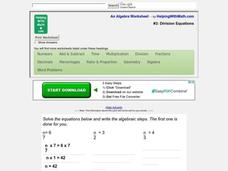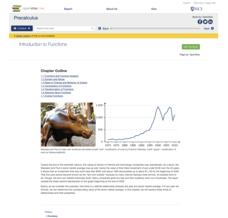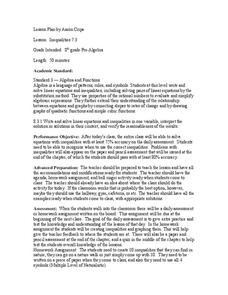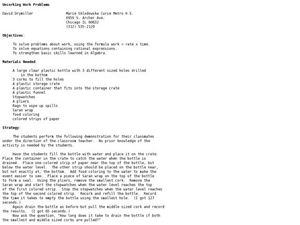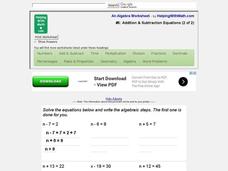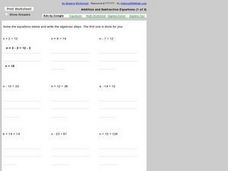Curated OER
Division Equations
In this division worksheet, students solve algebraic problems containing fractions. This one-page worksheet contains 11 problems. Answers are provided. This worksheet may be completed on-line or produced in printed form.
Curated OER
Rational Function Graphs
Students use algebraic methods to represent and solve problems. Using a graphing calculator, students solve rational and inequality problems. They visually demonstrate solutions of functions through graphing. Students answer questions...
Curated OER
Solve Simple One-Step Linear Equation
Sixth graders solve one unknown number by using hands-on manipulatives after being introduced to the history of abstract mathematics through literature.
Curated OER
It's a Party! Solving Multi-step Equations
Students explore the concept of multi-step equations. In the multi-step equation lesson, students solve equations by the 'party method'. Students make a flip book that shows the steps in solving multi-step equations.
Curated OER
One Step Equations
In this solving equations worksheet, students solve 11 one step equations. Students subtract a constant to isolate the variable.
Key Curriculum Press
Applications of Exponential Functions
Exponential functions are the name of the game. Young mathematicians can work through each of the eight worksheets by evaluating functions, applying logarithms, completing logarithmic functions, and building inverse functions. This...
Balanced Assessment
Transformation I
Rewriting expressions in different forms is an essential algebra skill. Support the development of this skill by using a task that asks scholars to begin with a linear, quadratic, and rational expression and then manipulate...
Rice University
Precalculus
Take a step beyond Algebra 2. Learners use the eBook to learn concepts from the typical Precalculus course. Content starts off with a short review of functions in general and moves on to the basic functions, finishing up with more...
Curated OER
Math Honors 2: Semester 1 Review
In this activity, learners review topics from Algebra 2. Topics include synthetic division, rational algebraic expressions, quadratic functions, imaginary number, composite functions, and inverse of a function. The three-page activity...
West Contra Costa Unified School District
Fractional Exponents
Wow! Here is a handout packed full of tips and worked-out solutions to supplement instruction on fractional exponents. The lesson introduces and thoroughly explains the Algebra II concept, and closes with a...
Curated OER
The Rational Root Theorem
In this algebra worksheet, 11th graders find the rational roots of an equation, by setting it to zero and solving for x. They can also use synthetic division and p/q to help find and eliminate rational root values. There are 19 problems...
Curated OER
Linear Patterns in Data
Eighth graders extend their learning of graphing linear equations and are introduced to connecting patterns in tables and graphs to represent algebraic representations. They then determine patterns and extrapolate information from these...
Helping with Math
#10: Solving Equations (2 of 2)
In this prealgebra activity, pupils perform addition, subtraction, multiplication, or division operations to solve for an unknown. There are 12 problems to be solved. Use this as a quiz to assess how well your class is grasping the skill...
Curated OER
Sloping and Intersecting a Linear Function
Learners examine and discuss typical linear equations, and the difference between a linear and nonlinear equation. They observe examples of linear equations and complete a worksheet.
Curated OER
Earthquakes
Eighth graders demonstrate the mathematical components of a scientific problem as well as illustrate how real world problems can be solved using math. They demonstrate math skills such as rate calculation, graphing, and linear equations.
Curated OER
Solving Quadratics
In this algebra worksheet, students solve quadratics using the quadratic formula and completing the square. There are 13 questions on this test.
Curated OER
Inequalities 7.3
Graph inequalities and discuss the difference in their slopes. Learners observe rate of change as they compare linear, quadratic, and cubic functions.
Curated OER
Uncorking Work Problems
Explore the concept of work with your class, using bottles, water, and corks to calculate work, while using the formula work = rate x time. Students conduct multiple experiments, timing how long it takes for water to drain out of the...
Helping with Math
#6: Addition and Subtraction Equations (2 of 2)
This printable contains 12 basic equations to be solved. The first one is worked out as an example, and the answers for all can be found by clicking on a "Show Answers" box found on the website. The publisher has identified this as...
Helping with Math
#5: Addition & Subtraction Equations (1 of 2)
Single-step addition or subtraction operations are applied in order to solve these 12 simple equations. An answer key is available, not so much for you, but perhaps to be used by learners as a self-correction tool. Note that the...
Helping with Math
Solving Equations with Two-Stepping! (2 of 4)
Multi-step problems are part of the progression when learning to solve equations. These 12 problems require only two steps to arrive at an answer. Either print the page out to assign as homework, or have learners write down the problems...
Curated OER
Mathematics Within: Algebraic Patterns
Students investigate the concept of using proportions to compare quantities while also practicing calculations for foreign exchange rates. They develop the skill of solving for unknown quantities of money while using an algebraic equation.
Curated OER
Rational Numbers
In this Algebra I worksheet, 9th graders identify properties from the real number system and use the distributive property to collect simplify expressions with parentheses. The one page interactive worksheet contains five multiple...
Inside Mathematics
Graphs (2006)
When told to describe a line, do your pupils list its color, length, and which side is high or low? Use a learning exercise that engages scholars to properly label line graphs. It then requests two applied reasoning answers.


